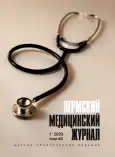Оценка качества ортопедического лечения пациентов с полным отсутствием зубов
- Авторы: Бажин А.А.1, Казаков С.В.1, Урсакий О.Н.1, Старкова А.В.1, Асташина Н.Б.1
-
Учреждения:
- Пермский государственный медицинский университет имени академика Е.А. Вагнера
- Выпуск: Том 40, № 1 (2023)
- Страницы: 108-116
- Раздел: Методы диагностики и технологии
- URL: https://bakhtiniada.ru/PMJ/article/view/144135
- DOI: https://doi.org/10.17816/pmj401108-116
- ID: 144135
Цитировать
Полный текст
Аннотация
Цель. Оценка результативности стоматологического ортопедического лечения больных с полным отсутствием зубов с применением съемных пластиночных протезов с использованием интегральных качественно-оценочных показателей. Актуальность исследования продиктована необходимостью повышения качества ортопедического лечения пациентов с полным отсутствием зубов за счет внедрения новых композиционных материалов, применение которых обеспечивает высокую прочность протетических конструкций. Для объективной оценки эффективности стоматологического ортопедического лечения пациентов с применением съемных пластиночных протезов, модифицированы интегральные подходы, основанные на расчете качественно-оценочных показателей.
Материалы и методы. С целью повышения качества ортопедического лечения пациентов с полным отсутствием зубов разработана конструкция полного съемного пластиночного протеза с комбинированным базисом и метод его изготовления, основанный на применении цифровых технологий. В ходе работы проведена оценка результативности лечения пациентов с полным отсутствием зубов в отдаленные сроки наблюдения при помощи интегральных качественно-оценочных показателей.
Результаты. Разработаны и опробованы клинико-лабораторные этапы изготовления новой конструкции, сочетающие в себе аналоговые и цифровые метолы. В результате клинических исследований установлено, что на показатель интегральной оценки качества проведенного ортопедического лечения вид конструкции полного съемного пластиночного протеза значительным образом не влияет, за исключением критерия целостности протеза.
Выводы. В результате клинических исследований установлено, что на показатель интегральной оценки качества проведенного ортопедического лечения вид конструкции полного съемного пластиночного протеза значительным образом не влияет, за исключением критерия целостности протеза, введение композиционного материала на основе стекловолокна в конструкцию комбинированного протеза позволяет улучшить прочностные свойства базиса протеза, увеличить эксплуатационные характеристики конструкции. Использование CAD/CAM-технологий обеспечивает возможность применения высокопрочных композитных материалов, дает достаточную точность при изготовлении каркаса комбинированного полного съемного пластиночного протеза. За счет удовлетворительных физико-механических свойств применение разработанной конструкции способствует прогнозируемому увеличению долговечности протезов.
Полный текст
Открыть статью на сайте журналаОб авторах
А. А. Бажин
Пермский государственный медицинский университет имени академика Е.А. Вагнера
Автор, ответственный за переписку.
Email: aleksei.bazhin2012@yandex.ru
ассистент кафедры ортопедической стоматологии
Россия, ПермьС. В. Казаков
Пермский государственный медицинский университет имени академика Е.А. Вагнера
Email: aleksei.bazhin2012@yandex.ru
кандидат медицинских наук, доцент кафедры ортопедической стоматологии
Россия, ПермьО. Н. Урсакий
Пермский государственный медицинский университет имени академика Е.А. Вагнера
Email: aleksei.bazhin2012@yandex.ru
кандидат медицинских наук, доцент кафедры ортопедической стоматологии
Россия, ПермьА. В. Старкова
Пермский государственный медицинский университет имени академика Е.А. Вагнера
Email: aleksei.bazhin2012@yandex.ru
кандидат медицинских наук, ассистент кафедры ортопедической стоматологии
Россия, ПермьН. Б. Асташина
Пермский государственный медицинский университет имени академика Е.А. Вагнера
Email: aleksei.bazhin2012@yandex.ru
доктор медицинских наук, заведующая кафедрой ортопедической стоматологии
Россия, ПермьСписок литературы
- Лебеденко И.Ю., Каливраджиян Э.С., Ибрагимов Т.И., Брагин Е.М. Протезирование при полном отсутствии зубов (руководство по ортопедической стоматологии). Международный журнал экспериментального образования 2011; 9: 17–18.
- Рединов И.С., Метелица С.И., Страх О.О. Повышение эффективности повторного лечения пациентов при полном отсутствии зубов на нижней челюсти. Фундаментальные исследования 2014; 10–2: 356–359.
- Alhajj M.N. et al. Determination of occlusal vertical dimension for complete dentures patients: an updated review. Journal of oral rehabilitation 2017; 44 (11): 896–907.
- Арутюнов С.Д. Клиническое применение усовершенствованной методики реставрации съемных пластиночных зубных протезов после поломки. Современные проблемы науки и образования 2016; 1: 26–26.
- Берлов А.В., Николаева И.Ю. Реабилитация съемными протезами стоматологических пациентов при полной и частичной адентии зубов. Вестник по педагогике и психологии Южной Сибири 2015; 4.
- Рубникович С.П., Грищенков А.С. Психологический профиль стоматологических пациентов при протезировании традиционными полными съемными протезами и съемными протезами с опорой на дентальные имплантаты. Стоматолог 2019; 1: 71–76.
- Russo L.L., Salamini A. Removable complete digital dentures: A workflow that integrates open technologies. The journal of prosthetic dentistry 2018; 119 (5): 727–732.
- Zmudzki J., Chladek G., Kasperski J. Biomechanical factors related to occlusal load transfer in removable complete dentures. Biomechanics and modeling in mechanobiology 2015; 14 (4): 679–691.
- Каливраджиян Э.С., Брагин Е.А., Жолудев С.Е. Руководство по стоматологическому материаловедению. М.: Изд. МИА 2013; 88.
- Шутурминский В.Г. Результаты сравнительных исследований физико-механических свойств полипропиленовых и акриловых пластмасс. Инновации в стоматологии 2015; 1 (7).
- Dur S. et al. An optimally solving dentistry internal purity in heat polymerized acrylic resin with different polymerization methods. Systematic Reviews in Pharmacy 2020; 11 (3): 974–980.
- Yakovishin L.A., Tkachenko E.V. Composite materials based on dental acrylic plastic and chitosan. Chimica Techno Acta 2021; 8 (4): 20218413.
- Петрикас О.А., Трапезников Д.В., Маслов А.Н., Петрикас И.В. Изучение прочности на изгиб акриловых и бис-акриловых материалов для провизорных протезов после их починки. Проблемы стоматологии 2018; 14 (2).
- Остроголов Д.Ф. Методика изготовления упрочненного базиса съемных пластиночных протезов. Актуальні проблеми сучасної медицини: Вісник української медичної стоматологічної академії 2018; 8 (3 (23)).
- Шулятникова О.А., Рогожников Г.И., Порозова С.Е., Гридина В.О. Пат. РФ на изобретение № RU2631050 С от 08.11.2016. Способ изготовления армированного базиса съёмного протеза. М., 2017.
- Dobrzański L.A. et al. Metallic skeletons as reinforcement of new composite materials applied in orthopaedics and dentistry. Archives of Materials Science and Engineering 2018; 92 (2): 53–85.
- Scribante A., Vallittu P.K., M. Özcan Fiber-reinforced composites for dental applications. BioMed Research International 2018; 2018.
- Асташина Н.Б., Митрущенков Ю.Н., Бажин А.А. Пат. РФ на полезную модель RU 194083 от 08.04.2019 г. Комбинированный полный съемный протез. М., 2019.
- Афанасьева В.В., Арутюнов С.Д., Муслов С.А. Расчет модуля упругости соединительного слоя слоистой системы, моделирующей пластинчатый зубной протез после починки. Актуальные проблемы и достижения в медицине 2015; 162–166.
- Абакаров С.И., Алимский А.В., Антоник М.М., Арутюнов А.С. Ортопедическая стоматология: национальное руководство в двух томах, второе издание. М.: ГЭОТАР-Медиа 2022; 520.
Дополнительные файлы






